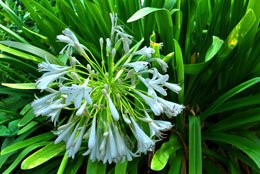Caring for Agapanthus plants revolves around providing sufficient moisture according to the prevailing environmental conditions. Learn how to grow and care for these plants from the following article.

Agapanthus is a popular garden plant, native to South Africa. Also known as the African lily or lily of the Nile,the Agapanthus is a herbaceous, perennial plant, and bears flowers in clusters during the summer. However, there are some varieties that begin flowering during late spring, till the onset of fall as well. While flowers in shades of blue and violet are common, you can find these plants bearing white flowers as well. Caring for this plant is simple and can be done using basic gardening tips.
It is best to grow Agapanthus in sunny locations. While some require full sunlight for healthy growth, other varieties can thrive in partial shade. Hence, you can select the suitable variety according to your garden location.
These plants grow well in moderately fertile, moist soil that does not have drainage problems. Remember that this summer flowering plant neither tolerates dry soil, nor waterlogged conditions. If you are growing these in pots, select a large container (ideally 12 inch in diameter) having drainage holes at the bottom, and add regular potting media in it.
Growing
Spring time is ideal for planting these in cold regions. To get the desired soil conditions, you can supplement heavy garden soil with farmyard compost, peat moss, manure, and organic mixtures. Make a hole (2" by 4") in the garden soil or potting mixture. Place one rhizome clump bearing healthy green leaves in the hole, and cover the root portion with soil. If you are growing several bulbs at a time, maintain a spacing of 6 inches between them.
Watering
Water the plants immediately after plantation till the soil is well-soaked. Frequent watering is advisable for both garden plants and potted plants. This will promote quick development of the roots and upper shoot. As the plants get established, you can reduce the amount of water supplied to them. The water requirements will vary according to the climatic conditions. For example, the watering frequency should be higher during spring and summer, compared to fall and autumn.
Care Before Flowering
In order to ensure production of healthy Agapanthus flowers, prepare the plants prior to the flowering season. During spring, older leaves should be removed and organic compost must be mulched around the stem. Cutting old foliage allows the plants to conserve energy for flower development. The organic mulch aids in retaining moisture and controlling weed growth. Supplementing poor soil with adequate organic fertilizer will help in producing larger blooms.
Winter Care
During winter, the fleshy root system of these plants should be protected from extreme cold conditions. This is not a concern for container gardening, as you can transfer the potted plants indoors anytime. For outdoor plants, dig the soil to uproot the rhizome part, making sure that it is not damaged. Divide the root clumps into individual sections, and store them in a cardboard box lined with newspapers from all sides. Allow the clumps to overwinter till spring time.
As you can see, caring for Agapanthus is no different than caring for other perennial plants, except for overwintering. The blue agapanthus flowers look beautiful in any landscape design, especially when grown in groups. Each of the individual bloom resembles a lily with petals arranged in a tubular shape. You can cut the flower stalks at a specific length, and use the flowers for interior decoration as well.






 Agapanthus is a popular garden plant, native to South Africa. Also known as the African lily or lily of the Nile,the Agapanthus is a herbaceous, perennial plant, and bears flowers in clusters during the summer. However, there are some varieties that begin flowering during late spring, till the onset of fall as well. While flowers in shades of blue and violet are common, you can find these plants bearing white flowers as well. Caring for this plant is simple and can be done using basic gardening tips.
Agapanthus is a popular garden plant, native to South Africa. Also known as the African lily or lily of the Nile,the Agapanthus is a herbaceous, perennial plant, and bears flowers in clusters during the summer. However, there are some varieties that begin flowering during late spring, till the onset of fall as well. While flowers in shades of blue and violet are common, you can find these plants bearing white flowers as well. Caring for this plant is simple and can be done using basic gardening tips.